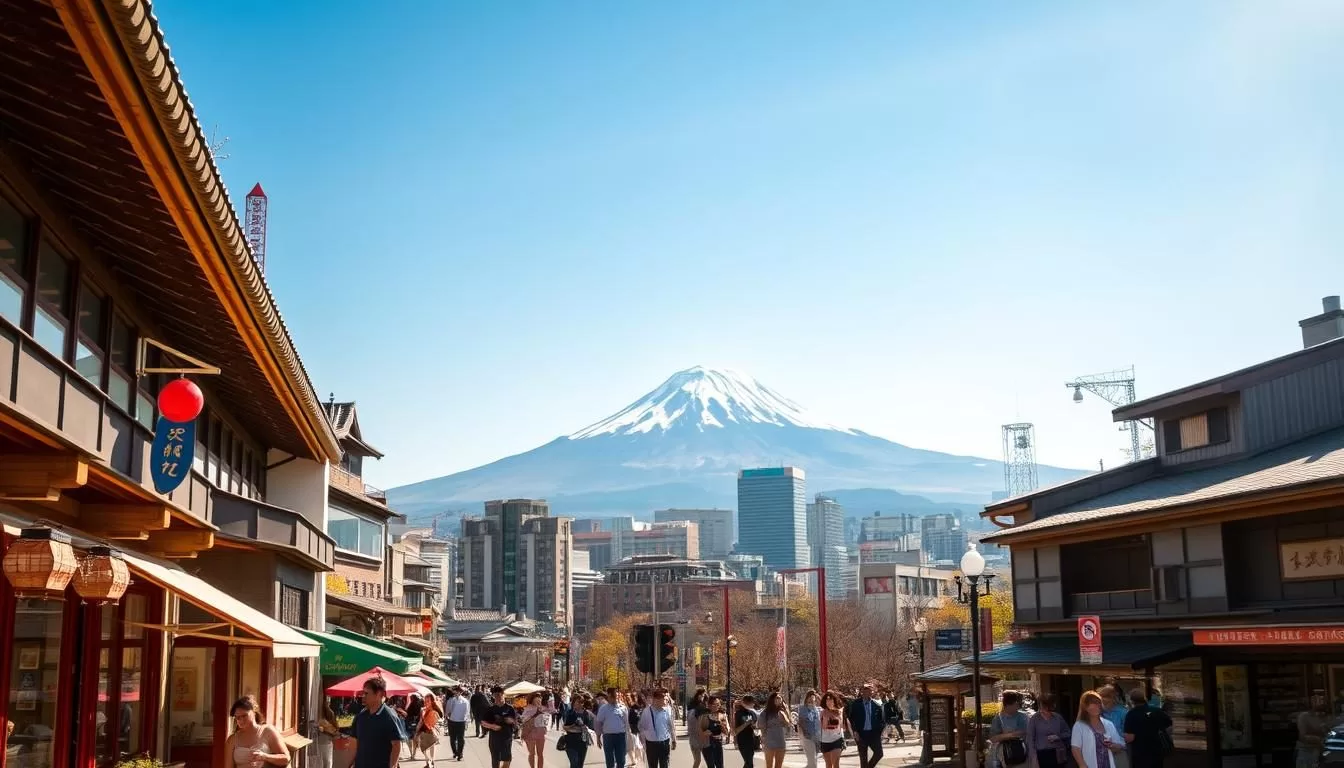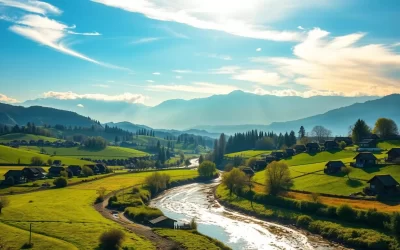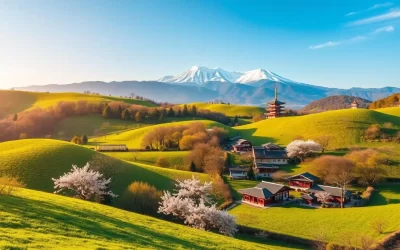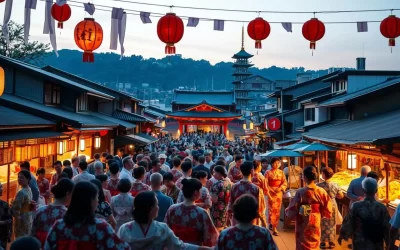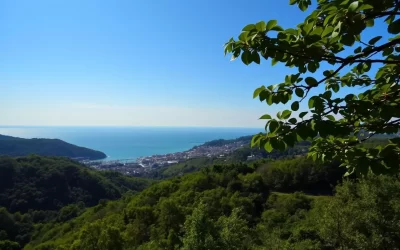Planning a trip to Japan’s Kantō region can be a daunting task, especially when considering the time of year to visit. The region, home to Tokyo and surrounding prefectures, experiences four distinct seasons, each offering unique experiences.
Understanding the local climate and weather patterns is crucial for a comfortable travel experience. With hot and humid summers and mild winters, the best time to visit Japan depends on your preferences. Whether you’re looking for cherry blossoms in the spring or autumn foliage, knowing what to expect can make all the difference.
As you plan your trip, consider the factors that impact your travel experience, such as typhoon season and peak tourist times. By doing so, you’ll be able to make the most of your visit to Japan and enjoy the month you’ve chosen to travel.
Understanding the Kantō Region’s Climate
The Kantō region, home to Tokyo and surrounding areas, experiences a diverse climate throughout the year. This diversity is largely due to its geographic location and the influence of various weather patterns.
Geographic Overview of the Kantō Region
The Kantō region is situated on the eastern coast of Honshu, the largest island of Japan. It encompasses the Tokyo metropolitan area and surrounding prefectures, including Kanagawa, Chiba, Saitama, Ibaraki, Tochigi, and Gunma. The region’s geography is characterized by a mix of coastal plains, mountains, and valleys.
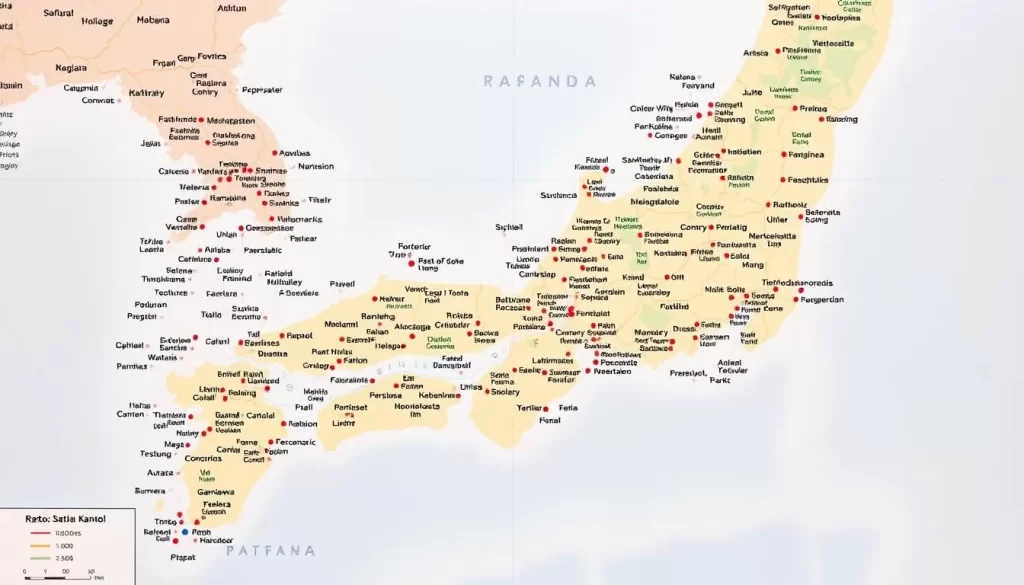
Four Distinct Seasons of Kantō
The Kantō region is known for its four distinct seasons, each offering unique experiences for travelers. Spring brings mild temperatures and the famous cherry blossoms, while summer is hot and humid. Autumn is characterized by comfortable temperatures and vibrant foliage, and winter is generally mild but can be cool, especially in the mornings and evenings.
Understanding these seasonal changes is crucial for planning your trip. For instance, the cherry blossom season is a major draw, but it requires precise timing. In contrast, autumn foliage offers a more relaxed pace.
How Climate Change Is Affecting Travel Seasons
Climate change is significantly impacting the traditional seasonal patterns in the Kantō region. Rising temperatures are causing cherry blossoms to bloom earlier, and altering the typical weather patterns. This shift affects not only the timing of seasonal attractions but also the overall travel experience.
Travelers need to be aware of these changes to plan effectively. For example, the earlier blooming of cherry blossoms may require adjusting your spring travel plans. Similarly, changing typhoon patterns can impact late summer and early autumn travel.
Spring in Kantō: Cherry Blossoms and Mild Weather
As the winter chill dissipates, the Kantō region transforms into a vibrant spring paradise, making it an ideal time to visit. The season brings with it a plethora of experiences, from the breathtaking cherry blossoms to various cultural festivals.
March to May Weather Patterns
During spring, the Kantō region enjoys mild and pleasant weather, with temperatures gradually warming up from March to May. Daytime temperatures often reach the 15°C to 20°C range, making it perfect for outdoor activities. However, it’s not uncommon to experience cooler days, especially in the mornings and evenings, so packing layers is advisable.
Cherry Blossom Season: Timing and Best Viewing Spots
The cherry blossom season is a highlight of spring in Kantō. The blooming period typically starts in late March and peaks in early April. Some of the best cherry blossom viewing spots include:
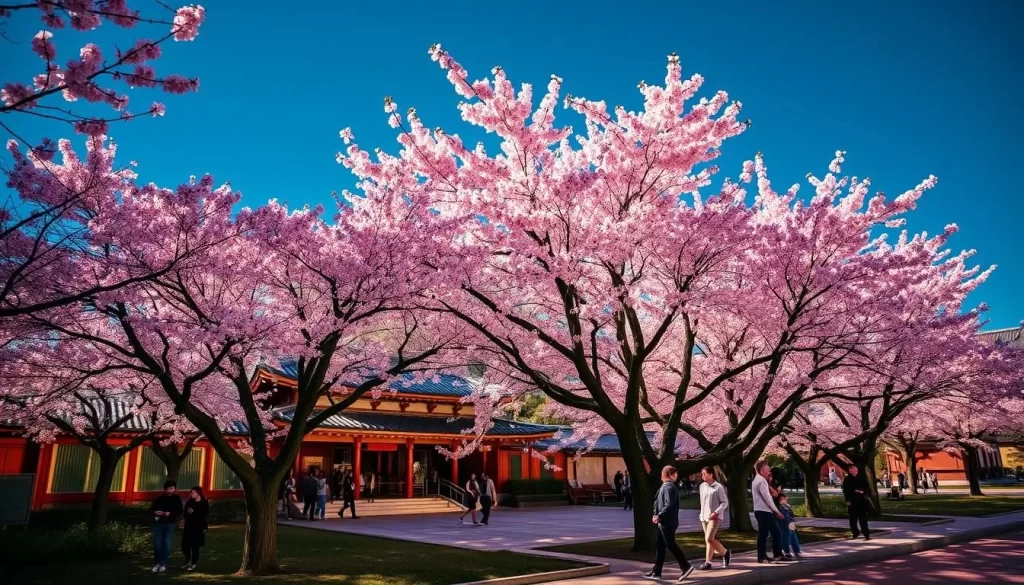
Ueno Park in Tokyo is renowned for its over 1,000 cherry blossom trees, creating a spectacular canopy of pink.

Shinjuku Gyoen, a large park in Shinjuku, Tokyo, is another popular spot, offering a mix of Japanese, French, and English garden styles amidst the blossoms.
Spring Festivals and Events
Spring in Kantō is not just about cherry blossoms; it’s also a time for various festivals and events. Hanami (cherry blossom viewing) parties are a common sight, where people gather to admire the blossoms and enjoy food and drinks. Other events include spring flower festivals and traditional cultural performances.
Pros and Cons of Spring Travel
Visiting Kantō during spring has its advantages and disadvantages. On the positive side, the weather is generally mild, and the cherry blossoms are a major draw. However, it’s also one of the busiest and most expensive times to visit, especially during peak bloom and Golden Week. Planning ahead can help mitigate some of these challenges, such as booking accommodations and popular attractions in advance.
Navigating Golden Week: Japan’s Busiest Travel Period
As you plan your trip to Japan, understanding Golden Week is crucial for a stress-free travel experience. Golden Week is a week-long holiday period in Japan that takes place from April 29 to May 5, during which many Japanese people take time off to travel, making it one of the busiest travel periods in the country.
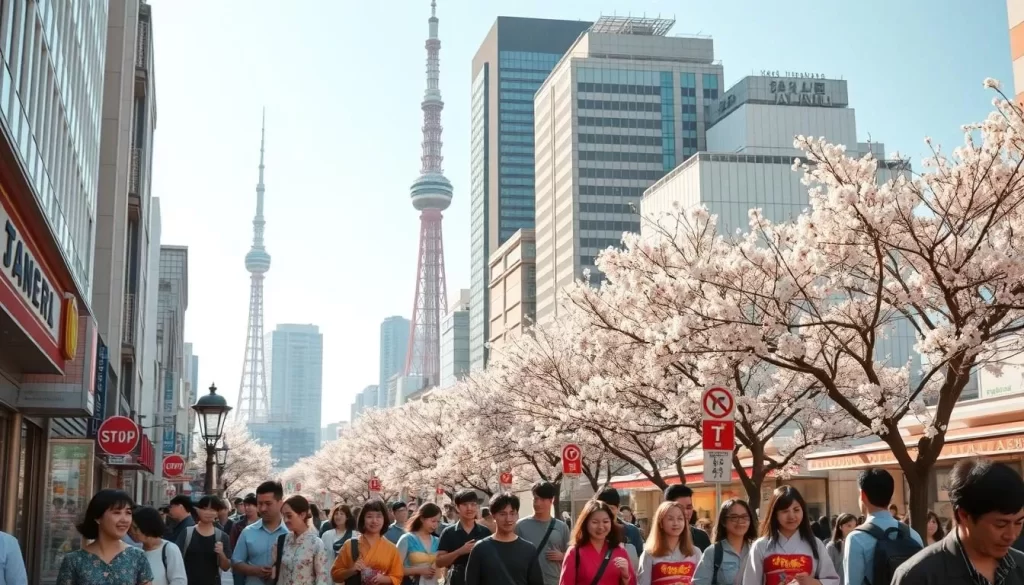
What Is Golden Week and When Does It Occur?
Golden Week is a collection of national holidays that occur within a week, typically between April 29 and May 5. The exact dates can vary from year to year, but it usually includes Showa Day, Constitution Day, Greenery Day, and Children’s Day. During this time, many businesses, including some tourist attractions, may close or operate on reduced hours.
How to Plan Around the Crowds
To navigate Golden Week effectively, it’s essential to plan ahead. Booking accommodations and popular attractions well in advance is crucial, as prices tend to skyrocket and availability dwindles. You can also consider visiting less crowded places or exploring alternative destinations within the Kantō region.
For instance, instead of visiting popular Tokyo spots, you might venture into neighborhoods like Shimokitazawa, known for its unique shops and artwork, or Yanaka, which boasts historic charm. These areas are generally less crowded with tourists, offering a more local experience.
Alternative Destinations During Peak Season
If you’re looking to avoid the crowds altogether, consider exploring other destinations within the Kantō region during Golden Week. Day trips to nearby cities or towns can provide a refreshing break from the bustling travel hubs. You can also look into indoor activities or visit attractions that are less likely to be crowded, making your time visit more enjoyable.
By being flexible with your travel plans and considering alternative destinations, you can still have a fulfilling experience during Golden Week. Whether it’s exploring local neighborhoods or taking day trips, there are plenty of ways to make the most of your trip to Japan during this busy period.
Summer in Kantō: Heat, Humidity, and Festivals
Summer brings a unique blend of sweltering weather and festive atmosphere to the Kantō region, making it a fascinating time to visit. As you plan your trip, understanding the climate and cultural events of this season can help you make the most of your travel experience.
June to August Weather Conditions
The summer months in Kantō are characterized by hot and humid weather, with temperatures often reaching their peak in August. It’s not uncommon for the mercury to soar above 30°C (86°F), accompanied by high humidity levels that can make the heat feel even more oppressive. To stay comfortable, it’s essential to dress in light, breathable clothing and stay hydrated by drinking plenty of water.
During this time, the region experiences a significant amount of sunshine, making it ideal for outdoor activities. However, the heat can be overwhelming, so it’s crucial to plan your days accordingly, perhaps by visiting outdoor attractions during the cooler morning or evening hours.
Rainy Season (Tsuyu): What to Expect
Before the peak summer heat sets in, Kantō experiences its rainy season, known as Tsuyu, typically from mid-June to mid-July. This period is marked by frequent rain showers and overcast skies, providing a brief respite from the impending heat. While it might not be the best time for outdoor sightseeing, the rain brings a lush vibrancy to the region’s landscapes, making it a beautiful time for nature lovers.
It’s advisable to pack accordingly, bringing waterproof gear and planning for indoor activities during this time. Many cultural events and festivals continue through the rainy season, offering a unique glimpse into local culture.
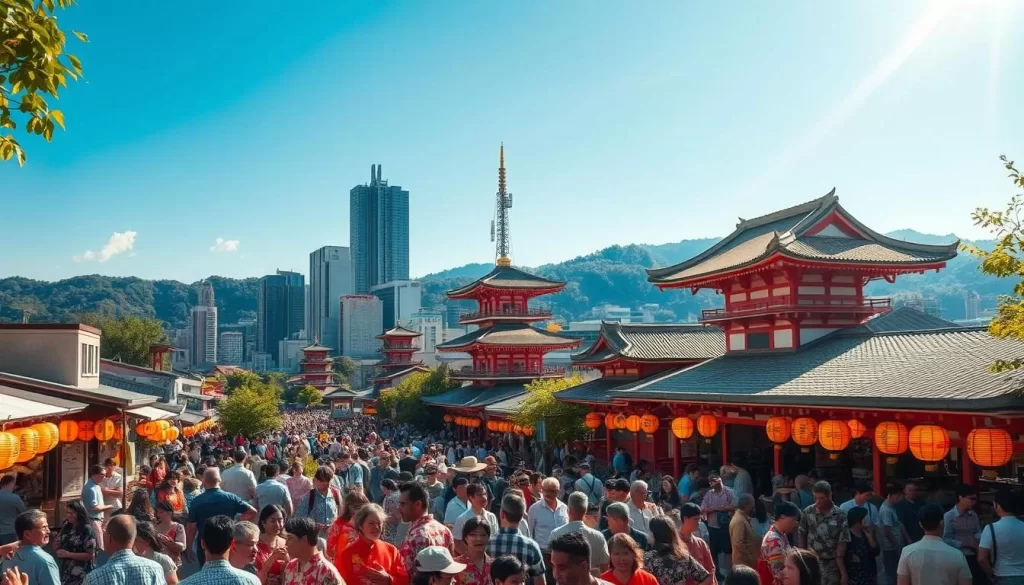
Summer Festivals and Cultural Events
Despite the heat, summer is a vibrant time in Kantō, with numerous festivals and cultural events taking place throughout the region. One of the highlights is the Obon festival, which honors the spirits of one’s ancestors. It’s a time of traditional dances, lanterns, and family reunions, offering a deep insight into Japanese culture.
Other events include various local matsuri (festivals), which often feature food stalls, traditional performances, and fireworks. These events are not only entertaining but also provide a chance to experience the local community’s spirit and hospitality.
Beating the Heat: Indoor Attractions and Day Trips
To escape the summer heat, Kantō offers a plethora of indoor attractions, from modern shopping centers and museums to traditional temples and gardens with cooling effects. Visiting these places can provide a welcome respite from the outdoor heat.
For those looking to explore beyond the urban heat, day trips to nearby mountainous regions or coastal areas can be very refreshing. Places like the Japanese Alps or the coastal towns along the Pacific offer cooler climates and scenic landscapes, making them perfect for day trips.
By understanding the weather patterns and making informed choices about when and where to visit, you can enjoy all that Kantō has to offer during the summer months. Whether you’re interested in cultural events, outdoor activities, or simply looking for ways to beat the heat, Kantō in the summer has something for everyone.
Typhoon Season: What Travelers Need to Know
The Kantō region’s typhoon season can be challenging for travelers, but with the right knowledge, you can navigate it effectively. Typhoons, known as “taifu” in Japanese, are intense tropical cyclones that can bring heavy rain and strong winds to the area.
Typhoon Patterns and Peak Months
Typhoons in the Kantō region typically occur between July and October, with the peak months being August and September. During this time, the weather can be quite unpredictable, with typhoons potentially developing or changing direction rapidly. Understanding these patterns can help you plan your trip more effectively.
It’s essential to stay informed about weather forecasts during your travel plans. Japan has a robust weather forecasting system, and you can easily access updates through various apps and local news.
Safety Precautions and Travel Insurance
When traveling during typhoon season, it’s crucial to take necessary safety precautions. This includes staying informed about weather conditions, having a contingency plan, and considering travel insurance that covers natural disasters. Many insurance policies offer coverage for trip cancellations or interruptions due to severe weather.
Additionally, familiarize yourself with local emergency procedures and the location of nearby shelters. In the event of a typhoon, your safety is paramount, so always follow local instructions and guidelines.
How Typhoons Affect Transportation and Itineraries
Typhoons can significantly impact trains and other forms of transportation in the Kantō region. Delays and cancellations are common during severe weather, and in some cases, entire days can be lost due to disrupted services. It’s vital to build flexibility into your itinerary to accommodate potential disruptions.
By understanding how typhoons can affect your travel plans, you can better prepare for the unexpected and make the most of your trip, even during challenging weather conditions.
Autumn in Kantō: Fall Foliage and Comfortable Temperatures
Autumn in Kantō brings a kaleidoscope of colors and comfortable temperatures, perfect for exploring this beautiful region. As the summer heat dissipates, the landscapes transform into a picturesque blend of warm hues, making it an ideal time for travel and outdoor activities.
September to November Weather Patterns
The autumn season in Kantō, spanning from September to November, is characterized by mild temperatures and decreasing humidity. September can still be quite warm, but by October, the temperatures have cooled down significantly, making it an ideal time to visit. November is particularly pleasant, with crisp air and the fall foliage at its peak.
Best Spots for Viewing Autumn Leaves
Kantō is home to numerous spots renowned for their stunning autumn foliage. Some of the top locations include:
- The Imperial Palace East Garden in Tokyo, known for its beautiful ginkgo trees.
- Nikko National Park, which offers a spectacular display of autumn colors.
- Kamakura, famous for its temples and shrines surrounded by fall foliage.
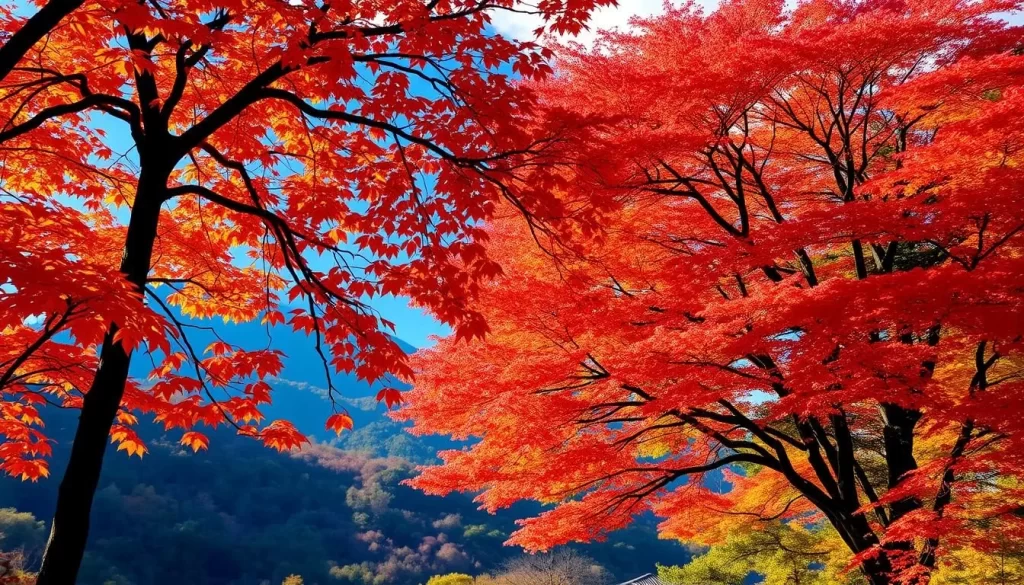
Fall Festivals and Cultural Experiences
Autumn in Kantō is not just about the fall foliage; it’s also a time for various cultural festivals and events. The region comes alive with traditional fall festivals, offering a glimpse into Japan’s rich cultural heritage. Visitors can enjoy local food, participate in traditional dances, and experience the warm hospitality of the locals.
Pros and Cons of Autumn Travel
Traveling to Kantō during autumn has its advantages and disadvantages. On the positive side, the comfortable weather makes it ideal for sightseeing, and the autumn foliage is a major draw. However, popular spots can get crowded, and accommodation prices might be higher. Planning your trip just before or after the peak autumn season can help mitigate these issues, offering a more relaxed travel experience.
Winter in Kantō: Mild Temperatures and Holiday Illuminations
Winter in Kantō brings a unique charm, with mild temperatures and stunning holiday illuminations. As you plan your trip, you’ll find that this season offers a distinct experience, different from the bustling crowds of other times of the year.
December to February Weather Conditions
During the winter months, Kantō experiences relatively mild weather compared to other parts of Japan. December is particularly pleasant, with dry conditions prevailing before the winter school holidays begin. However, the days are shorter, with sunset around 4:30 pm in Tokyo, so it’s essential to plan your activities accordingly.
Average Temperatures: Daytime temperatures range from 10°C to 15°C (50°F to 59°F), while nighttime temperatures can drop to around 0°C to 5°C (32°F to 41°F).
Winter Illuminations and Seasonal Attractions
One of the highlights of winter in Kantō is the spectacular winter illuminations. Tokyo and other cities are adorned with millions of lights, creating a magical atmosphere. Popular spots include Shinjuku Gyoen, Tokyo Skytree, and Yokohama’s Minato Mirai 21 district.
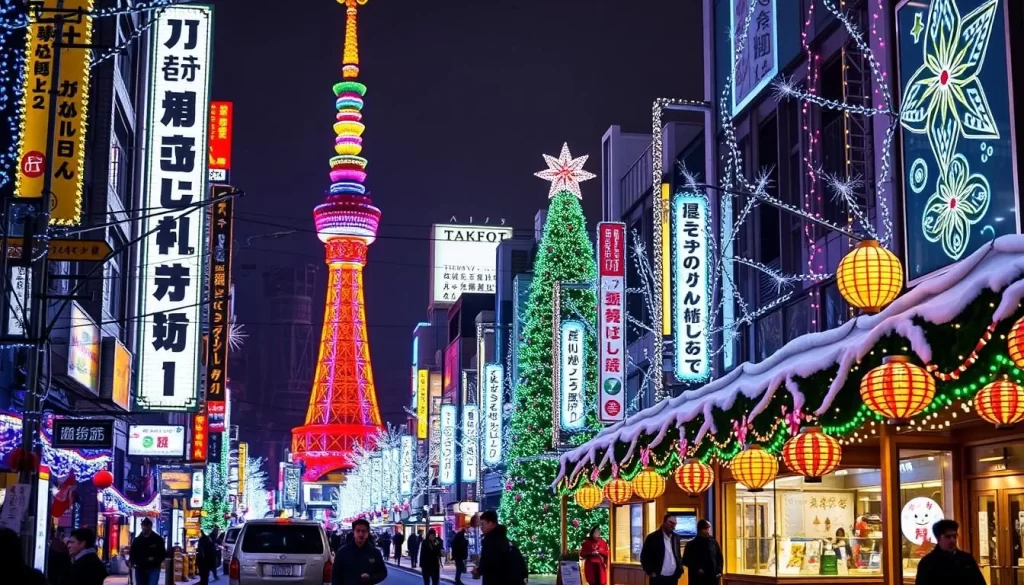
New Year Celebrations and Traditions
The New Year (Oshogatsu) is a significant celebration in Japan, and Kantō offers a unique experience during this time. Visit shrines and temples, such as Meiji Shrine in Tokyo, to witness the traditional hatsumode (first shrine visit of the year).
Winter Travel Advantages and Challenges
Traveling to Kantō in winter has its advantages, including lower tourist numbers and potential cost savings. However, you should be prepared for the cooler weather and shorter daylight hours. By understanding these factors, you can make the most of your trip and enjoy the unique cultural experiences that winter has to offer.
Kantō Region, Japan: Best Months for a Weather-Savvy Trip
The Kantō region in Japan offers diverse experiences throughout the year, but some months are better than others for a weather-savvy trip. Understanding the climate and tourist patterns can significantly enhance your travel experience.
Optimal Weather Windows: March-May and October-November
The periods from March to May and October to November are considered optimal for visiting the Kantō region. During these times, the weather is mild and pleasant, making it ideal for outdoor activities and sightseeing. In the spring, you can enjoy the beautiful cherry blossoms, while autumn brings stunning foliage.
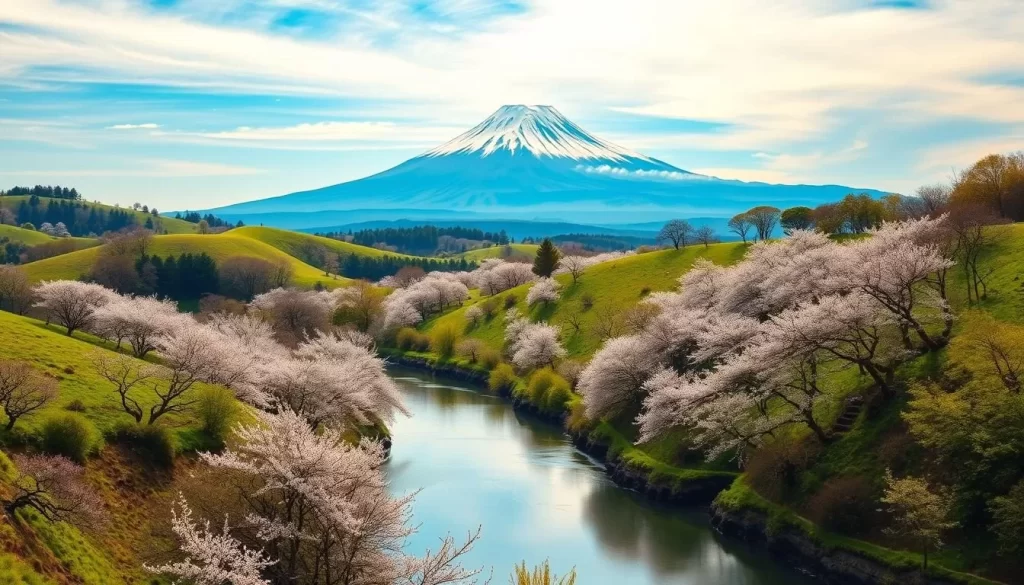
Budget-Friendly Travel Periods
If you’re looking to save on your trip, consider traveling during the shoulder season. The months immediately before and after the peak tourist seasons often offer better deals on accommodations and tourist attractions. For the Kantō region, this means visiting in late spring (after the cherry blossom peak) or early autumn.
| Period | Weather | Tourist Season | Cost |
|---|---|---|---|
| March-May | Mild, pleasant | Peak (Cherry Blossom) | Higher |
| June-August | Hot, humid | Peak (Summer) | Higher |
| October-November | Comfortable | Moderate | Moderate |
| December-February | Cool to cold | Low | Lower |
When to Avoid: Peak Tourist Seasons
It’s essential to be aware of the peak tourist seasons if you’re looking to avoid large crowds. Golden Week, which typically occurs at the end of April and beginning of May, is one of Japan’s busiest travel periods. Similarly, the New Year (around January 1st) and Obon week in mid-August are also peak travel times. These periods can lead to crowded attractions and higher prices for accommodations and travel.
By planning your trip around these peak seasons, you can enjoy a more relaxed experience in the Kantō region. Consider the optimal weather windows and budget-friendly periods to make the most of your time to visit and enjoy your travel in this beautiful part of Japan.
Tokyo-Specific Weather Considerations
Tokyo’s weather is uniquely influenced by its urban environment, creating distinct microclimates across the city. As you plan your visit, understanding these weather nuances can significantly enhance your experience.
Urban Heat Island Effect
The Urban Heat Island effect makes Tokyo’s temperature higher than surrounding areas, especially during summer. This phenomenon occurs because urban surfaces like pavement and buildings absorb and retain heat, making the city feel warmer.
During the peak summer months, this can mean a difference of several degrees between Tokyo and its more rural surroundings. Being aware of this can help you prepare for the heat and humidity.
Tokyo’s Microclimate vs. Surrounding Areas
Tokyo’s microclimate varies not just from surrounding areas but also within different parts of the city itself. For instance, areas near large parks or waterfront districts tend to be cooler than densely built-up neighborhoods.
Understanding these variations can help you plan your itinerary, choosing cooler spots during hot weather or more sheltered areas during rainy or windy conditions.
Best Neighborhoods for Seasonal Activities
Different Tokyo neighborhoods shine during different seasons. For cherry blossoms, Ueno and Shinjuku Gyoen are must-visits. In autumn, Meiji Jingu Gaien’s ginkgo trees are a highlight. Asakusa hosts various traditional festivals throughout the year, making it a great place to experience Tokyo’s cultural heritage.
By focusing on specific neighborhoods that are known for their seasonal activities, you can create a more fulfilling and focused itinerary that captures the essence of Tokyo’s seasonal charm.
Day Trips from Tokyo: Seasonal Weather Variations
Day trips from Tokyo offer a chance to experience the diverse seasonal weather patterns of the Kantō region. As you venture out, you’ll discover that different destinations have their own unique weather stories to tell, influenced by their geography and climate.
Hakone and Mt. Fuji Weather Patterns
Hakone and Mt. Fuji, popular day-trip destinations, experience distinct seasonal weather variations. In the spring, mild temperatures and cherry blossoms make for a picturesque visit. Summer brings warmer weather, ideal for enjoying Lake Ashi cruises. Autumn foliage is stunning, with the leaves changing colors against the backdrop of Mt. Fuji. Winters can be chilly, with potential snowfall, making it a serene and less crowded time to visit.
Kamakura and Coastal Areas
Kamakura and other coastal areas have a different climate compared to inland destinations. Spring and autumn are pleasant, with mild temperatures and fewer crowds than Tokyo. Summer can be hot and humid, but the beaches attract many visitors. Winters are generally mild, with some cold snaps. The coastal location means that weather patterns can be influenced by the ocean, often resulting in a more moderate climate.
Nikko and Northern Kantō
Nikko and the northern parts of the Kantō region experience more pronounced seasonal changes compared to Tokyo. Winters are colder, with significant snowfall, making it a great destination for winter sports. Spring arrives later than in Tokyo, and the cherry blossoms bloom a bit later as well. Autumn colors appear earlier in Nikko than in Tokyo, offering a beautiful contrast to the temples and shrines. Understanding these seasonal variations can help you plan your day trips to make the most of your time.
By considering the seasonal weather variations for different day trip destinations from Tokyo, you can better plan your travels to enjoy the best that each location has to offer at any given time of the year.
Packing Guide for Kantō’s Changing Seasons
Kantō, Japan, with its varied seasonal weather, requires travelers to be meticulous in their packing to ensure a comfortable and enjoyable trip. Understanding the seasonal variations and being prepared is key to making the most of your visit.
Spring Essentials
During spring, the Kantō region experiences mild temperatures, with average highs gradually warming up. You’ll need to pack layers for your trip, including lightweight jackets and comfortable clothing for the blossoming weather. Comfortable walking shoes are a must as you plan to explore the region’s famous cherry blossom spots and other outdoor attractions.
As spring progresses, the weather can be quite pleasant, but it’s also a time of occasional rain showers. Consider bringing an umbrella or a raincoat to be prepared for unexpected rain. Your spring packing list should balance comfort with the need to be prepared for variable weather conditions.
Summer Must-Haves
Summer in Kantō is characterized by hot and humid weather, with temperatures often reaching their peak in July and August. To stay comfortable, pack lightweight, breathable clothing that allows for good airflow. Don’t forget to include sunscreen, a hat, and sunglasses to protect yourself from the sun.
Given the region’s occasional summer rain showers, it’s wise to carry a lightweight rain jacket or a compact umbrella. Staying cool and dry will make your summer exploration of Kantō much more enjoyable.
Autumn Necessities
Autumn brings a comfortable coolness to the Kantō region, making it an ideal time to explore both urban and rural areas. Your packing list should include layers, as the temperature can fluctuate significantly between day and night. Warm clothing for the evenings and comfortable shoes for walking are essential.
As the season progresses, the weather remains generally mild, but being prepared for occasional rain is advisable. Including a versatile rain jacket or umbrella in your luggage will ensure you’re ready for any unexpected weather changes.
Winter Packing List
Winter in Kantō is typically mild, but it still requires packing warm clothing, including wool socks, layers, and a good winter coat. The region can experience light rain showers, so carrying an umbrella or rain jacket is also recommended. This preparation will allow you to enjoy the cozy winter markets and beautiful illuminations without discomfort.
For winter exploration, consider packing gloves, scarves, and warm socks to keep you comfortable in the cold. Good walking shoes with non-slip soles are also crucial for navigating potentially icy or wet conditions. Balancing warmth with style while keeping your luggage manageable is key to a stress-free winter trip.

Transportation Considerations by Season
The changing seasons in the Kantō region bring different challenges and opportunities for travelers, particularly when it comes to transportation. Japan’s excellent transportation system helps travelers stay comfortable while exploring in all seasons.
Trains are generally the most reliable form of transportation year-round, though they can be extremely crowded during peak travel periods. Understanding how to navigate this system during different seasons is crucial for a smooth trip.
Impact of Weather on Train Travel
The weather significantly affects train travel in the Kantō region. During the spring and autumn seasons, mild weather makes train travel comfortable. However, during the summer, heat and humidity can make crowded trains uncomfortable, while in winter, cold weather may cause delays due to snow or freezing conditions.
Seasonal preparedness is key to navigating these challenges. For instance, during typhoon season, it’s essential to check weather forecasts regularly and plan accordingly, as typhoons can cause significant disruptions to train services.
Seasonal Traffic Patterns
Traffic patterns in the Kantō region vary significantly with the seasons. During peak travel seasons like Golden Week in spring and the New Year holidays in winter, roads and highways can become congested. In contrast, during the off-peak seasons, traffic is generally lighter.
Understanding these patterns can help travelers plan their journeys more effectively, whether they’re using trains, buses, or rental cars. For example, bicycle rentals can be an excellent option during spring and autumn when the weather is mild, offering a pleasant way to explore local areas.
Best Transportation Options by Season
The best transportation options in the Kantō region vary by season. Trains are reliable year-round, but their crowdedness during peak seasons should be considered. Buses and rental cars offer alternatives, especially for areas not well-covered by train networks.
By balancing cost, comfort, and convenience, travelers can choose the best transportation methods for their needs during different seasons. For instance, in the summer, using air-conditioned buses or trains can be a comfortable choice, while in winter, opting for heated transportation can enhance the travel experience.
Accommodation Strategy for Different Seasons
Kantō’s accommodation landscape changes significantly with the seasons, making it essential to plan ahead. Whether you’re visiting during the peak cherry blossom season or the more subdued winter months, understanding the accommodation dynamics can greatly enhance your travel experience.
Peak vs. Off-Peak Pricing
Accommodation prices in Kantō fluctuate considerably between peak and off-peak seasons. During peak periods such as cherry blossom season and Golden Week, prices tend to skyrocket, and availability becomes limited. It’s not uncommon for hotels and ryokans to increase their rates by 20-50% during these times. In contrast, off-peak seasons, particularly the period between mid-January and mid-March, offer more affordable rates and a wider range of options.
Booking in advance is crucial during peak seasons. Accommodations should be booked at least 3-6 months in advance to secure the best rates and ensure availability. For off-peak travel, you may have more flexibility to book closer to your travel dates.
Best Areas to Stay by Season
The best area to stay in Kantō can vary depending on the season. During cherry blossom season, areas like Ueno Park in Tokyo or Kawagoe near Tokyo offer stunning views and are worth considering. In the summer, coastal areas such as Kamakura or Yokohama might be more appealing due to their beachside locations. For autumn foliage, Nikko or other areas with beautiful fall colors are ideal.
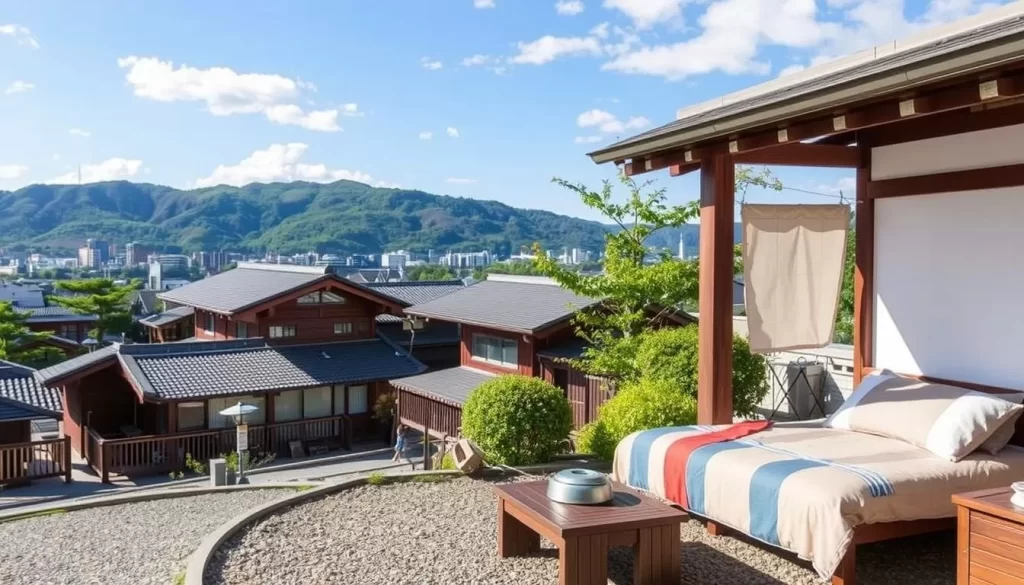
Booking Windows and Seasonal Availability
Understanding the optimal booking window is key to securing the right accommodation at the best price. For peak seasons, booking 3-6 months in advance is recommended. For off-peak seasons, you can often find good deals by booking a few weeks to a month in advance. Keep an eye on accommodation availability and pricing trends for your desired travel dates to make informed decisions.
Special Seasonal Experiences in Kantō
From the blooming cherry blossoms of spring to the illuminations of winter, Kantō’s seasons are filled with unique experiences. Each season offers a distinct flavor of the region, making it a perfect destination for any time of the year.
Beyond Cherry Blossoms: Spring Experiences
In the spring, Kantō transforms into a vibrant landscape. While cherry blossoms are a highlight, there are many more experiences to enjoy. You can visit the Tsukiji Outer Market for fresh sushi, or take a stroll in the beautiful Imperial Palace East Garden.
Spring is also a great time to explore Kantō’s many festivals, such as the Sanja Matsuri in Asakusa, which showcases the region’s rich cultural heritage.
Summer: Indoor and Outdoor Activities
Summer in Kantō is characterized by hot and humid weather, but there are plenty of ways to enjoy the season. You can cool off at one of the many on-sen (hot springs) or visit the Odaiba area for its beach and shopping complexes.
Outdoor enthusiasts can enjoy hiking in Nikko National Park or exploring the Kamakura coastline.
Autumn: Cultural Immersion Opportunities
Autumn brings comfortable temperatures and stunning fall foliage to Kantō. It’s an ideal time for cultural immersion, with many traditional festivals and events taking place. You can visit the Meiji Shrine to experience the serene autumn atmosphere.
The season also offers a chance to enjoy seasonal food like kuri (chestnuts) and kabocha (pumpkin).
Unique Cold-Weather Experiences in Winter
Winter in Kantō brings its own set of unique experiences. One of the highlights is the New Year (Oshogatsu) celebrations, where you can visit shrines and temples to experience the traditional Japanese culture.
You can also enjoy the beautiful winter illuminations, such as the “Midtown Christmas” display at Tokyo Midtown. For a warm and cozy experience, try hot pot dishes and amazake (sweet sake), which are popular winter treats.
Winter is a great time to explore Kantō’s cultural dimensions, from traditional Japanese cuisine to unique winter festivals.
Planning a Multi-Season Trip to Kantō
The Kantō region offers a diverse range of experiences across different seasons, making it ideal for a multi-season trip. With careful planning, you can enjoy the region’s unique attractions and cultural events throughout the year.
Two-Week Itinerary Options
When planning a two-week trip to Kantō, you can explore various itinerary options that cater to different interests and travel styles. One approach is to spend the first week experiencing Tokyo’s urban delights, from historic temples to modern pop culture, and then use the second week to explore surrounding areas like Nikko and Hakone.
For instance, you could dedicate a few days to visiting Tokyo’s iconic landmarks, such as Shibuya Crossing and the Tokyo Skytree, and then take a day trip to Kamakura or Yokohama. This mix of city and suburban exploration can provide a well-rounded travel experience.
Combining Kantō with Other Japanese Regions
Japan’s excellent trains system, including the Shinkansen (bullet train), makes it relatively easy to combine a visit Japan trip to the Kantō region with other parts of the country. You can efficiently travel to major cities like Kyoto, Osaka, and Hiroshima, allowing for a multi-region itinerary.
When planning your time, consider the seasonal highlights of different regions. For example, visiting Kyoto during cherry blossom season or autumn foliage can be a great complement to your Kantō experience. By strategically planning your days and using the Japan Rail Pass, you can maximize your travel experience across multiple regions.
Conclusion
With its unique seasonal charm, the Kantō region is a year-round destination that promises something special for every kind of traveler. As you’ve seen, each season brings its own unique experiences, from the breathtaking cherry blossoms of spring to the vibrant summer festivals, the stunning autumn foliage, and the magical winter illuminations.
The key to enjoying the Kantō region lies in understanding its climate and seasonal variations. By doing so, you can plan your trip during the optimal times, whether you’re looking for the best weather, budget-friendly options, or specific activities. The spring (March to May) and autumn (September to November) seasons are particularly noteworthy for their mild weather and plethora of cultural events.
When planning your visit, consider what you want to experience. Are you drawn to the summer’s vibrant festivals or the serene beauty of winter’s landscapes? Perhaps the spring cherry blossoms or the autumn foliage are more to your liking. Whatever your preference, the Kantō region has something to offer, making it a versatile destination for travelers.
By being mindful of the seasonal tourism trends, temperature patterns, and rainfall trends, you can tailor your trip to suit your interests and budget. This weather-savvy planning will enable you to maximize your enjoyment of the region’s diverse attractions and experiences.
In conclusion, the Kantō region is a dynamic and captivating destination that offers a rich tapestry of experiences throughout the year. By understanding the seasonal rhythms and planning accordingly, you can have a truly memorable and enjoyable trip to this fascinating part of Japan.
The above is subject to change.
Check back often to TRAVEL.COM for the latest travel tips and deals.
Here are some Tours & Sightseeing suggestions that might pique your interests!
